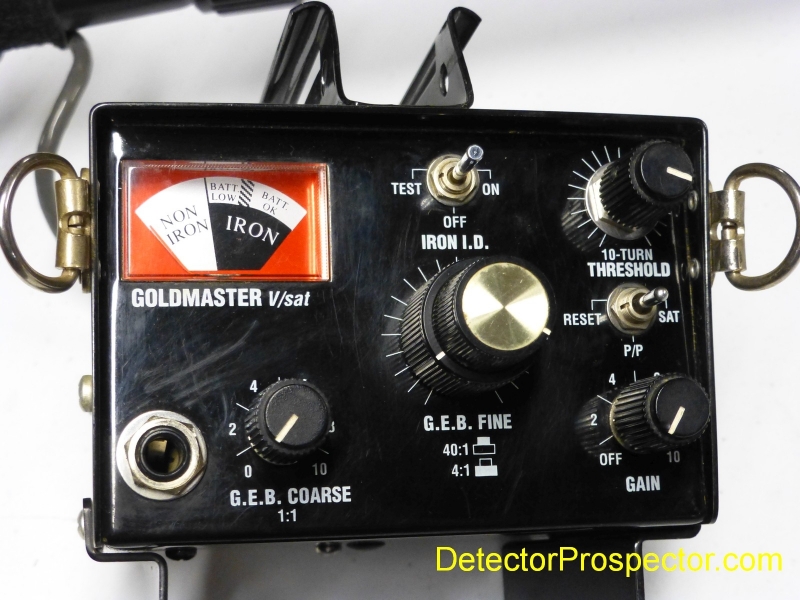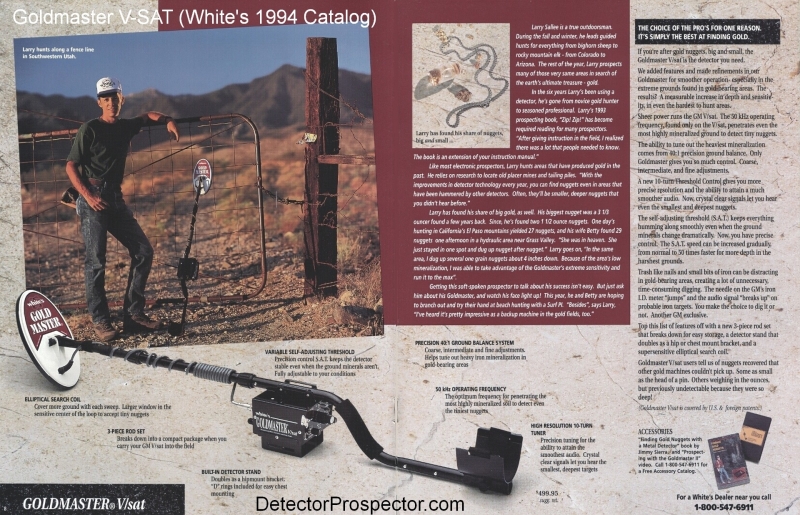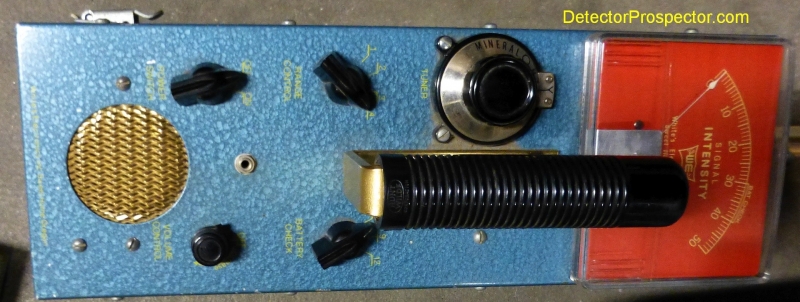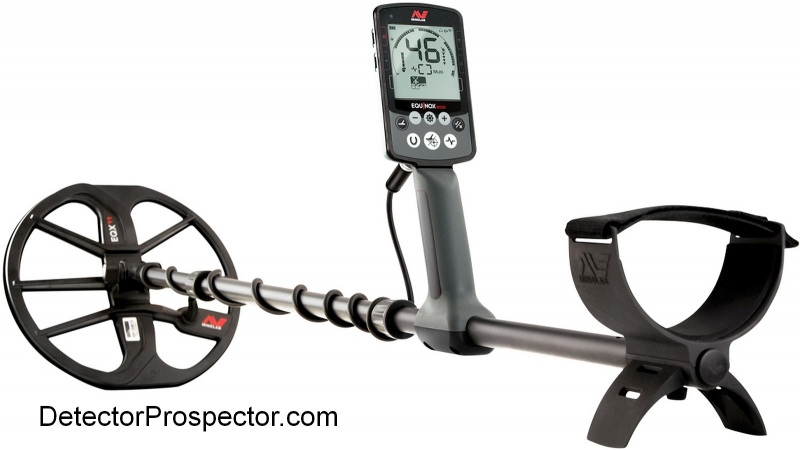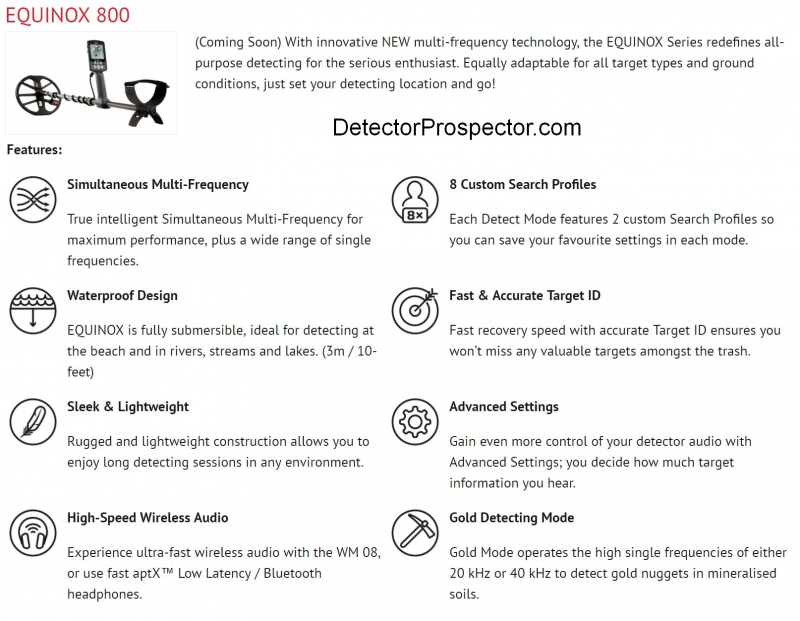-
Posts
19,760 -
Joined
Content Type
Forums
Detector Prospector Home
Detector Database
Downloads
Everything posted by Steve Herschbach
-
Getting hot VLFs to run well in bad ground is challenging. Generally you have to reduce the gain until the machine behaves. That may mean a setting of 3 or 4 instead of 10 but if the machine is overloading it is useless. Large coils are more susceptible to overload from ground mineralization. The Goldmasters can be run in the worst of ground if you just accept them for what they are. Coil failures are not uncommon. If the machine squeals no matter what, a coil swap is needed to eliminate that possibility. Coils and coil cables fail at rates far exceeding the control box on most any model of detector. The older foam filled coils were prone to the foam breaking down internally when subjected to ongoing impacts on rocks or other environmental stress.
-
I used them all - Goldmaster II, Goldmaster V-SAT, Goldmaster 3, Goldmaster 4/B, and GMT. They are all 50 kHz detectors except the GMT, which is 48 kHz. All share the same coils. The Goldmaster 3 was in some ways the most well thought of out of the series. When the 4/B came out White's made the switch from a control box that could be chest or hip mounted to the current coin detector type box. The 4/B was roundly panned by prospectors as a result plus the Fisher Gold Bug 2 came out about then, and that also put a hurt on 4/B sales. The GMT is actually more closely related to the MXT than the earlier Goldmaster models, which were pure analog. The main thing the GMT offers compared to the earlier models is automatic ground tracking. Just my opinion but any differences in depth and sensitivity are so small as to not matter between the various models. You could grab the GMT and I could grab a Goldmaster II or later and I would not feel outgunned. Click or double-click for larger image....
-
Again, fabulous thread! JR, Reg, maybe you can enlighten me on something I always wondered about. A large number of the big finds made early on in Oz were made when gold prices were low. That, and big finds were more common. I suspect that a lot of the gold got sold back then for prices far below what we can get now. I know I sold a lot back in the day for a lot less than I could get for it now. Of course at the time I thought the price was high and might go back down! Sometimes I do think that it is only the escalating price of gold that has kept people in the field. I like finding gold, but with today's diminished finds it would be hard to get very excited about prospecting if gold was only $300 an ounce.
-
It is a separate Minelab part number but very hard to find. It's just a 12V auto charger but the end that connects to the battery has to be sized correctly. I have quite a few 12V car adapters and will try all of them and report back. I am sure there is a cheap alternative that can be found.
-
From http://www.minelab.com/anz/go-minelabbing/news?article=322833 15 Nov 2017 Queensland man unearths giant gold nugget worth more than $50,000 with GPX 5000 A beautiful 38-ounce gold nugget, worth more than AU$50,000, has been uncovered in North Queensland by a dedicated prospector using a Minelab GPX 5000 detector. The life-changing find came just moments after he uncovered a three-ounce nugget worth some AU$4,000. “When I found the first nugget I was super stoked because that was my biggest ever,” said the Queenslander who wishes to remain anonymous. “I would have been really happy with just that but after I’d calmed down, I went back to the same spot, restarted my detector and after just two or three swings I found the big one.” “It’s fair to say I was emotionally overwhelmed at that time,” he said. Weighing more than a kilogram (1,176gms), the nugget was 15cms (six inches) below the ground and discovered thanks to the advanced gold-finding technology of the Minelab GPX 5000 detector. “It’s just incredible. I’d been looking in this particular area for a while that day and I was about ready to leave but I gave it another quarter of an hour and then with five minutes left I got this fairly good signal – not too loud but I was confident it was gold – so I started digging. “At first, I didn’t know just how big the nugget was because the scales I had with me only went up to 500grams. It wasn’t until later when I got home I found out I’d broken the kilo mark. “It was beneath some vegetation so it was a bit of a challenge to get to, but now I’m thinking maybe those roots are keeping some other big nuggets safe ready to be found another time.” The joyous prospector has named his find the Arcus Nugget because of the role nature played in its discovery. Arcus is Latin for rainbow. Driving back to camp the day before, he saw a double rainbow for the first time in his life. Ignoring the adage that gold is found at the end of rainbows, he identified the section of ground beneath the highest point of the arc and decided that was where he would look the next day. “I said to myself that’s where were going to find gold tomorrow but I never thought it would be so much.” He’s now negotiating to sell the nugget privately. A man who loves the bush, he got bitten by the prospecting bug about 10 years ago. That was when, during only his second trip out, he uncovered his first piece of gold. While finding the Arcus Nugget was clearly his biggest day in the field, the dedicated prospector has had plenty of other success with his GPX 5000. Earlier trips into his beloved bush have netted him hauls of four and two ounces. “The discovery is always really exciting. The trip when I found two ounces, for me at the time, that was ‘wow’.” Minelab’s Townsville dealer, Peter Cragg (above), was amazed to see the nugget. “It’s a fantastic story and goes to show that there are still big nuggets out there ready to be found if you have the right equipment and can spot the terrain. He found more than a kilo of gold in an area which has certainly had detectors go over it before. It makes you think what might still be out there!” he said. Minelab’s GPX 5000 is a proven favourite for serious gold prospectors, featuring exclusive technologies including Multi Period Sensing (MPS), Dual Voltage Technology (DVT) and Smart Electronic Timing Alignment (SETA). Coming with eight timings, each designed for optimum performance under different conditions, the high performance GPX 5000 can handle even the most severe ground while still maintaining excellent depth and gold sensitivity. Learn more about the GPX 5000 and Minelab’s full range of premium gold detectors here.
-

Minelab Equinox Full Specifications & Brochures
Steve Herschbach replied to Steve Herschbach's topic in Minelab Equinox Forum
Shhhhhhh! -

Fisher F75+ Announced
Steve Herschbach replied to Steve Herschbach's topic in First Texas - Bounty Hunter, Fisher & Teknetics
Yeah, First Texas is moving forward on a new PI project. It makes me wonder if the CZX/Mosca stalled out and they needed a new direction? I don’t know but the subject has been discussed on two prior threads here: June 13, 2017 Alexandre Tartar Joins First Texas June 14, 2017 Something New In The World Of PI Detectors? Back to the F75+ and the release of one item of information at a time. Apparently First Texas will introduce a transferable warranty along with the Plus models. Definitely about time - warranties should cover the product for the warranty period regardless of whether it changes hands. First Texas was one of the last holdouts when it comes to the warranty only applying to the original owner. No more word on what the det3ctors itself does that is actually new however. -
-

Five Frequency Times Eight
Steve Herschbach replied to Steve Herschbach's topic in Minelab Equinox Forum
From http://www.detectorprospector.com/forum/topic/4488-minelab-equinox-multi-iq-technology-part-2/ “* 20 kHz and 40 kHz are not available as single operating frequencies in EQUINOX 600. The Multi-IQ frequency range shown applies to both EQUINOX 600 and 800. This diagram is representative only. Actual sensitivity levels will depend upon target types and sizes, ground conditions and detector settings.“ Access to the Gold Mode and therefore the 20 kHz and 40 kHz single frequencies is limited to the Equinox 800. “Gold Detecting Mode - Gold Mode operates the high single frequencies of either 20 kHz or 40 kHz to detect gold nuggets in mineralised soils.” -
40 khz is the biggie Tom. There are piles of detectors that run around 19-20 khz and yes, that is a very good frequency for a general purpose nugget detector. Yet for many years people have gone to higher frequency machines like the 48 khz GMT, 71 kHz Gold Bug 2, 60 kHz Eureka Gold, 56 kHz Gold Racer for their small nugget detecting needs. The 45 khz Gold Monster is just the latest in the series of dedicated nugget detectors running at over 40 kHz. So while topping out around 18 - 22 kHz is good (more than good enough for most people), it has always been just a little short of where I have been hoping to get with a selectable frequency detector as regards both nugget and micro jewelry detecting. The Deus does a good job in that regard but for most people starting with no detector buying a standard Deus and then adding a HF coil option gets to be a real pricy situation at near $2K for a VLF detector with two coils. That will change if XP ever gets around to selling a model that comes with the HF coil as stock, as they have done in Africa (but nowhere else we know of). But then you get locked into 14 kHz on the low end. It may all very well be moot now as Multi-IQ proves it's stuff over time.
-
Here is a very new video that shows a Sun-Ray probe in use throughout. The big sell was target id via the detector. And as V3i/MXT Pro note -weight, wires, boxes, etc. were a turnoff for some. They were most popular early on with Minelab DD coil models that challenged lots of people's pinpointing skills.
-

Gold Master 66tr ... I Need Help With The Search Coil
Steve Herschbach replied to Murad's topic in White's Metal Detectors
I used to own a few of the old White's T/R detectors. In fact I still have one I keep around just for nostalgia sake. At over 40 years old they are long since obsolete technology. They can detect coin size objects at maybe 2-4 inches depending. They can't ground balance and so any mineralization at all really kills the depth. You can buy similar detectors here for $50 or less. The last couple I had were just given to me because they have no value unless in like new condition for people who collect old detectors. Surprisingly (to me) there are quite a few people who do that. As far as identifying which wires are which - I just do not know. That is why I offered the Geotech links. Coil Basics by Carl Moreland at Geotech -
The Dual Field thing is just about the coil design on the Surf PI. It is not a combined VLF and PI but just a simple PI detector, and without ground balance capability. In general it is really a detector best used for beach detecting and nothing else. Stick with machines on my Nugget Detector Guide if you do not wish to go astray. I quite honestly have listed almost every machine worth your consideration as a nugget detector and you can safely ignore the rest. The X-Terra 705 at $499 packs an incredible amount of features into a detector in that price range. It competes well with detectors costing hundreds of dollars more. They were $799 not too long ago and at that it was a great machine. At $499 its a smoking deal. The Gold Bug Pro has been incredibly popular in Africa and so is worth a look also. Just be very careful with any machines you might purchase as counterfeit detectors are a plague in Africa. Deal only with somebody very reputable you can trust. If you get offered a deal too good to be true consider that a counterfeit may be involved.
-

Gold Master 66tr ... I Need Help With The Search Coil
Steve Herschbach replied to Murad's topic in White's Metal Detectors
Welcome to the forum! If it was me I would try to find any newer used detector possible rather than work on a 50 year old relic. If that is not an option, I can’t help you personally with a wiring diagram. However, when it comes to that and making your own coils, etc. the absolute best source of information is the Geotech website and Geotech forum. -

Silver, Titanium And Wheat
Steve Herschbach replied to Gbonus uralias's topic in Metal Detecting For Coins & Relics
I have an ultrasonic cleaner - fabulous for cleaning jewelry, not much use for coins. -

Silver, Titanium And Wheat
Steve Herschbach replied to Gbonus uralias's topic in Metal Detecting For Coins & Relics
Great post GB! I used to be extremely careful with every coin I dug, treated them all like they might be worth a million bucks. The truth is most coins dug out of the ground are worth little more than the melt value. The 1940 dime is a perfect example. Worth maybe $1.40 in silver. The date and condition add no value. So what to do? I get out the silver polish and make them look pretty. The main thing is to be careful until you start getting a handle on what the key dates and values are. There are unfortunately very few high value coins in the 1900s not made of gold. 1800s and earlier coins get automatic attention. Excerpt of 1900 coins from this key date listing: Lincoln Cent 1909-S VDB, 1914-D, 1922-D Missing D Strong Reverse, 1955 Doubled Die Obverse Liberty Head Nickel 1912-S Indian Head (Buffalo) Nickel 1914/3, 1916 Doubled Die Obverse, 1918/7-D, 1926-S, 1935 Doubled Die Reverse, 1937-D 3 Legs Jefferson Nickel 1942-D/Horizontal D Winged Liberty (Mercury) Dime 1916-D, 1919-D, 1919-S, 1942/1, 1942/41-D Roosevelt Dime 1968-S No S, 1975-S No S Barber Quarter 1901-S, 1913-S Standing Liberty Quarter 1916, 1918/7-S, 1927-S Washington Quarter 1932-D, 1937 Doubled Die Obverse, 1950-D/S Barber Half Dollar 1904-S Walking Liberty Half Dollar 1919-D, 1921-D, 1921-S Franklin Half Dollar 1953-S Full Strike I won’t list the dollars because any silver dollar is a major find! The unfortunate other truth is that even if you find one of the key dates above, the condition will probably be such that there still is no real premium value involved besides being able to say you found a key date. A 1926 S nickel can be worth hundreds of dollars, but finding one that even rates as good condition would be extremely challenging. One in good condition is worth about $15. Good for a nickel for sure, but nothing you will retire on. Long story short anything not on the list above minted in the 1900’s is probably not worth more than face or silver melt value. Love the Mercs no matter the condition! -
This thread and your question are going to be put to the test soon. Now we have two new offerings to add to those originally listed: Nokta Impact 5 kHz, 14 kHz, and 20 kHz (15 kHz lowest to highest) XP DEUS Low Frequency Coil 4 kHz, 8 kHz, 12 kHz, and 18 kHz (14 kHz lowest to highest) Rutus Alter 4.4 kHz to 18 kHz in 0.2 kHz steps (13.6 kHz lowest to highest) White's V3i 2.5 kHz, 7.5 kHz, 22.5 kHz (20 kHz lowest to highest - bonus - runs in multifrequency mode) XP DEUS High Frequency Round 14 kHz, 30 kHz, and 59 kHz (45 kHz lowest to highest) XP DEUS High Frequency Elliptical 14 kHz, 30 kHz, and 81 kHz (67 khz lowest to highest) Plus arriving soon: Minelab Equinox 600 5 kHz, 10 kHz, and 15 kHz (10 kHz lowest to highest - bonus - runs in multifrequency mode) Minelab Equinox 800 5 kHz, 10 kHz, 15 kHz, 20 kHz, and 40 kHz (35 kHz lowest to highest - bonus - runs in multifrequency mode) The two new DEUS high frequency offerings have the widest frequency spread, but unfortunately they start at a pretty high starting point (14 kHz). They achieve very high frequencies by doing this but my own recent tests of machines like the 45 kHz Minelab Gold Monster and 71 kHz Fisher Gold Bug 2 plus my use of the DEUS HF elliptical coil make me question if there is much to be gained by the frequencies over 50 kHz. Ultra high frequencies are really hot on tiny objects but ground penetration also really suffers at the highest frequencies. I am not convinced that giving up the lower frequency options to reach kHz values as high as 81 kHz is worth the trade to all but a very few people. I suspect the vast majority of DEUS HF coil owners will employ the 14 kHz and 30 kHz options far more than the highest frequency option.
-
5F×8 (used in EQUINOX 800*) 5F×8 (Five Frequency Times Eight) provides five individual transmit frequencies in the one metal detector, selectable at the push of a button. Each transmit frequency optimises the detector for different size targets and conditions. EQUINOX 800 offers 5 single frequencies of 5, 10,15, 20, and 40 kHz, giving an 8 times range or ratio from 5 to 40, hence the 5F×8 technology designation. The individual selectable frequencies in EQUINOX 800 are: 5 kHz - Great for large silver coins 10 kHz - Good for small Roman hammered coins 15 kHz - A good general treasure detecting mode 20 kHz - Ideal for general treasure detecting and gold prospecting 40 kHz - Optimum sensitivity to very small gold nuggets Having five selectable frequencies gives the versatility that is equivalent to five conventional single frequency detectors. Note that EQUINOX Series detectors also feature Multi-IQ technology which allows you to operate all available single frequencies plus more, simultaneously. The option to operate your detector in a single frequency can be helpful if you are experiencing excessive ground noise when using the Multi-Frequency setting. *The Equinox 600 3F×3 (Three Frequency Times Three) offers three single frequencies of 5, 10, and 15 kHz, giving a 3 times range or ratio from 5 to 15, hence the 3F×3 technology designation. However, both the Equinox 600 and Equinox 800 offer identical Multi-IQ modes covering the full frequency range. The Equinox 600 simply disallows direct access to the 20 khz and 40 kHz single frequency modes. More on selectable frequency and frequency spread here.
-

Minelab Equinox Full Specifications & Brochures
Steve Herschbach replied to Steve Herschbach's topic in Minelab Equinox Forum
Steve, Multi-IQ is real and it is not a I am right and you are wrong thing. There is no doubt in my mind that Multi-IQ represents a genuine advancement. I am not making an argument against you by staking out a position in opposition to you. I simply taking a less aggressive stance than you are for various reasons. It is very important to you that Multi-IQ is the reason for the Equinox existence. I take the position that I would consider it the icing on the cake - I like the design of the machine regardless. It seems more like an argument over the semantics of "obsolete" and I don't want to argue. I therefore declare you the "winner" -

Minelab Equinox Unveiled!
Steve Herschbach replied to Steve Herschbach's topic in Minelab Equinox Forum
Like I said I am not trying to trash the Deus - what I am doing is describing my own preferences. The Deus is a groundbreaking detector that serves many people very well. However, the Equinox design decisions suit my uses better, that's all.. Everybody has favorite detectors and many people seem to get too attached to the machine - "insult my detector and you are insulting me buddy"! Pretty silly really for things that in most cases are just toys for grown ups.

